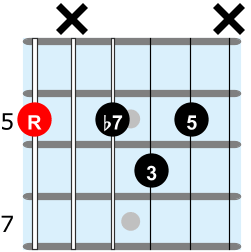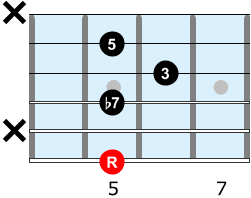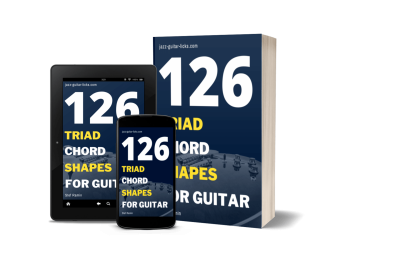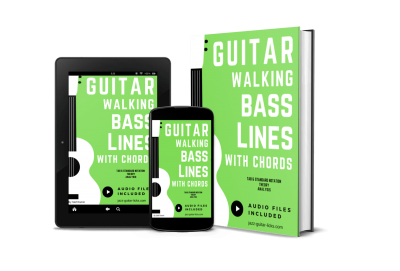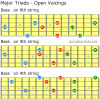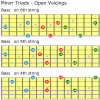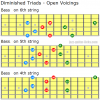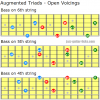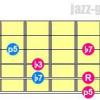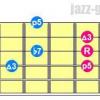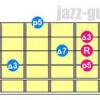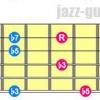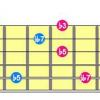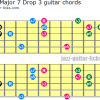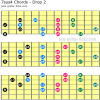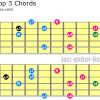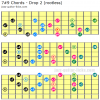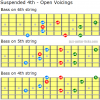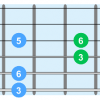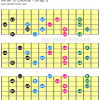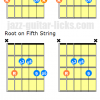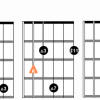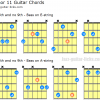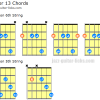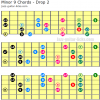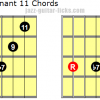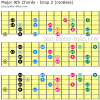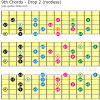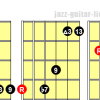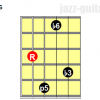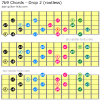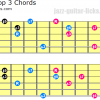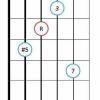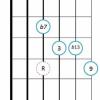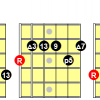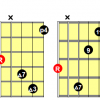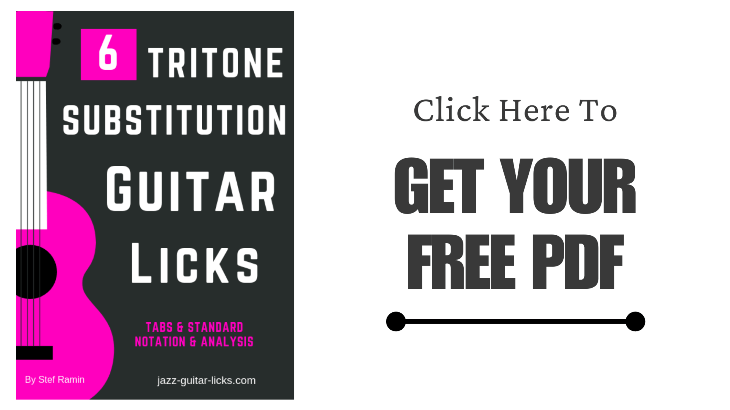Chords
Jazz Guitar Chords - Diagrams, Shapes And Formula Charts
Welcome in The Chord Section of Jazz Guitar Licks.com
You will find here tons of information about the most common to the most complex jazz guitar chord positions and voicings used in jazz music.
Each page (links at the bottom of this category) is dedicated to a specific type of chord including guitar shapes, formula charts and theory lessons.
Triads, seventh chords, extended chords, drop 2 voicings, drop 3 voicings, close and open positions are discussed in detail.
What Chords Are Used in Jazz?
Seventh chords are the most used used in jazz music, they are the backbone of jazz harmony.
They are built with four notes (root, third, fifth and seventh) and can be classified into several types :
- Major 7 (1 - 3 - 5 - 7)
- Minor 7 (1 - b3 - 5 - b7)
- Dominant 7 (1 - 3 - 5 - b7)
- m7b5 (half-diminished) (1 - b3 - b5 - b7)
- Diminished 7 (1 - b3 - b5 - bb7)
- Major Augmented 7 (1 - 3 - #5 - 7)
- Dominant 7 Augmented (1 - 3 - #5 - b7)
- Minor Major 7 (1 - b3 - 5 - 7)
- 7sus4 (1 - 4 - 5 - b7)
- 7sus2 (1 - 2 - 5 - b7)
Sixth chords can also be used in place of seventh chords, the main types are minor 6 (1 - b3 - 5 - 6) and major 6 (1 - 3 - 5 - 6).
Seventh chords are generally enriched with extra notes above the octave as the ninth (9), eleventh (11) and thirteenth (13).
These supplementary tones are used to add interesting colors to basic chords, thus giving number of possibilities as min9, maj9, dom9, min11, maj11, dom11, min13, maj13, dom13, 6/9 etc.
Some of these notes can be altered to bring tension and harmonic interest giving altered chords with weird and long names as 7#9, 7#5, 7b9b13, Maj7#11, some of them are simply noted with the "alt" extension.
And what about triads? Triads don't have what we call a "jazz sound", they are not very interesting except when they are superimposed to basic chords in order to add extensions.
How To Read Guitar Chord Diagrams?
Guitar chord diagrams, or guitar chord shapes are used to help visualize the chord positions on the guitar neck.
They can be presented in two ways, horizontally and vertically.
They represent the guitar neck with the position and the name of the chord tones.
Sometimes the fingers used to fret the notes are represented by a number related to each finger next to each string. 1 for index, 2 for middle finger, 3 ring finger, 4 little finger.
The black cross (X) means that the string should not be played.
The numbers below or on the left represent the fret number.
The root note (R) is represented by a red (or orange) circle. This note gives the name to the chord.
Most of the chord shapes shown in the lessons below are movable. Meaning that you can play them anywhere on the guitar neck while keeping the same position. The root will determine the key of the chord.
The two shapes below show how to play an A7 chord (dominant seventh).
You can play it in the key you want providing that you know the name of the root.
For example, by playing this shape with the root note at the seventh fret you get a B7. The root note at the tenth fret the you obtain a D7.
What Does Voicing Means?
A chord voicing is the way the notes of a chord are organized. The most used voicings are :
- Drop 2 voicing : The second highest note of a seventh chord in close position is dropped to the bass.
- Drop 3 voicing : The third highest note of is dropped to the bass.
- Drop 2-4 voicings : The second highest note and the fourth note are dropped to the bass.
Each drop chord can be inverted giving us more chord positions. These inverted chords can have third, fifth or seventh in the bass.
What Are Extended Chords?
Extended chords are chords that contains notes above the octave (9,11,13)
What Are Altered Chords?
Altered chords have notes altered by a flat (b) or a sharp (#). These tones are #9, b9, #11, b13, b5 , #5.
What Are Suspended Chords?
Suspended chords are neither minor nor major, these are chords where the third is replaced with the fourth or the second.
How To Practice Jazz Guitar Chords?
The first way is to play the chords related to each tone of each family of scale (melodic minor, harmonic minor, diatonic) .
In other words, you need to know how to harmonize each important scale in thirds and play the chords.
You will find some articles in the blog section on how harmonizing scales, so you will get the answers you need.
The second way, the most fun, is to play over common chord changes found in jazz as 2 5 1, 1 6 2 5, essential jazz blues progressions, rhythm changes, etc.
The final and most important way is to play over jazz standards.
Whatever the case, you need to know any jazz chord, how they are built, what are the chord tones therein, how to name them.
You have to recognize them, know how to write them and finally create you own chord positions depending on what you need.
Related PDF Methods
Jazz guitar chords are discussed in several PDF methods available on this website, check them out by clicking on the pictures.
-
Major Chords For Guitar - Diagrams And Theory
This guitar lesson covers open and close major triads chords. You will learn how to play them on the guitar using guitar neck using diagrams and formula charts for a better understanding of major triad voicings. -
Minor Triad Chords | Close, Open and Inverted Voicings | Guitar Diagrams
This jazz guitar lesson with diagrams, voicing charts and theory explains how to play close and open minor triads on the guitar. -
Diminished Triad Chords (dim) | Open and Closed Voicings with Guitar Shapes
This page contains guitar neck diagrams, shapes and formula charts to help you understand and play diminished triads on guitar. -
Augmented Triads (Aug) | Guitar Diagrams | Root & Inverted Voicings | Close and Open Positions
This lesson explains how to play augmented triads on the guitar using shapes, diagrams, and voicing charts. -
Minor Seventh (m7) Guitar Chords - Drop 2, Drop 3 and Drop 2 & 4 Voicings
This guitar lesson with diagrams and voicing charts show you how to play drop 2, drop 3 and drop 2-4 minor 7th chords on guitar. -
Dominant 7th Chords (7) Guitar Diagrams and Charts | Drop 2, Drop 3 and Drop 2-4 Voicings
This free guitar lesson contains theory, diagrams, formula charts and other important resources that will help you learn how to play drop 2, drop 3 and drop 2-4 dominant 7 chords on guitar. -
Major Seventh Chords (Maj7) - Drop 2, Drop 3 and Drop 2 & 4 Voicings with Guitar Diagrams
This lesson with guitar diagrams, theory and charts show you how to play drop 2, drop 3 and drop 2 & 4 major seventh chords. -
Half-Diminished Chords (m7b5) - Voicing Charts - Guitar Diagrams and Theory
This lesson shows how to play m7b5 drop 2 and drop 3 voicings on the guitar and what scale you can play for improvising over. This free course comes with guitar neck diagrams & formula charts to play half diminished chords. -
Diminished Seventh Chords For Guitar (Dim7) - Drop 2 and Drop 3 Voicings
This lesson explains what diminished 7 chords are and how to play them on guitar using charts, forms, and theory. -
Minor-Major Seventh (minMaj7) Guitar Chord Diagrams and Theory
This jazz guitar lesson with diagrams and voicing charts will help you understand how to play minor major 7 chords on the guitar. -
Dominant 7th Suspended 4th Chords (7sus4) | Drop 2 and Drop 3 Voicings with Guitar Diagrams
This free lesson provides drop 2 and drop 3 dominant 7 suspended 4 guitar chord diagrams with voicing charts. -
Dominant Seventh Flat Five Chords (7b5) | Guitar Diagrams and Voicings
The dominant seventh flat five chord is a dominant seventh chord with a fifth lowered by a semitone. This lesson will show you how to play the dominant 7b5 on the guitar. Drop 2 voicing charts, guitar diagrams and II-V-I examples. -
Dominant Seventh Sharp Ninth Chord (7#9) - Diagrams and Voicings For Guitar
How to play dominant seventh sharp ninth chords, 7#9, on the guitar. Check out this jazz guitar lesson with neck diagrams and voicing charts for a better understanding of this altered dominant chord. -
Sus4 Chords (Suspended Fourth) - Guitar Shapes and Voicing Charts
This guitar lesson with diagrams and charts explains what are sus4 chords and how to play them on guitar using closed and open voicings. -
6th Chords (6) Aka Major 6 - Guitar Diagrams and Voicings
This lesson with diagrams and shapes show how to play sixth chords on guitar. -
Minor 6th Chords (m6) | Guitar Chord Shapes and Voicing Charts
Minor 6 chords are made up of a root, a minor third, a perfect fifth and a sixth.This free guitar lesson with diagrams, drop 2 voicings charts, root and inverted positions explains how to play these four-note chords on the guitar. -
6/9 Chords aka 6add9 | Guitar Diagrams and Voicing Charts
This jazz guitar lesson with diagrams and voicing charts explains how 6/9 aka 6add9 chords are built and how to play them on the guitar. -
Major Seventh Sharp Eleventh Chords (maj7#11) - Guitar Diagrams and Voicing
How to play Lydian chords also known as major 7#11 chords on the guitar. Free lesson with diagrams and voicings. -
Minor 11 (m11) Guitar Chords - Diagrams and Voicings
This guitar lesson with diagrams and voicing charts will help you to play minor 11 chords on guitar. -
Minor 13 (m13) Guitar Chord Diagrams and Voicing Charts
Minor thirteenth chords can be used to replace or enrich any minor chord. This lesson with guitar shapes and voicing charts will help you play them on the guitar neck. -
Minor 9th Chords (m9) - Guitar Diagrams and Voicing Charts
A minor 9th chord can be seen as a minor seventh chord with a ninth added. This jazz lesson is about basic positions and drop 2 voicings with diagrams, shapes and formula charts to play them on the guitar. -
Dominant Eleventh Chords (11) - Guitar Diagrams and Voicings
This free guitar lesson is focused on dominant eleventh chords. You will find in this article four guitar diagrams to learn 11 chords and differentiate them from one other. -
Major 9th Guitar Chord Diagrams (Maj9) - Basic Positions and Drop 2 Voicings
In this lesson with guitar neck diagrams and formula charts you will see how major 9 chords are built, how to play them on guitar and what's the difference between add9, major 9 and 9 chords. -
9th Guitar Chords (9) | Voicings with Shapes and Theory
The purpose of this lesson with neck diagrams & voicing charts is to explain how to play basic & drop 2 dominant 9th chords on guitar -
Dominant 13th chords (13) - Guitar Voicing Shapes and Formulas
This lesson with diagrams and formula charts will show you how to play 13th chord voicings on the guitar. -
Minor b6 (mb6), minor b13 (mb13) Chords, minor 7 add b13 (m7add13) - Guitar Diagrams And Charts
This lesson explains the main differences between minor flat sixth (mb6), minor flat thirteenth (mb13) and minor 7 add b13 chords. Diagrams and formula charts to play them on guitar. -
7b9 Guitar Chords - Diagrams and Voicings
Dominant seventh flat ninth chords are built by lower the ninth of dominant 9 chords by one semitone. This jazz guitar lesson with diagrams and voicings will show you how to play 7b9 chords on the guitar. -
Dominant Seventh Sharp Fifth Chords (7#5) | Augmented Seventh Guitar Shapes and Voicing Charts
This free lesson with diagrams, voicings and charts will help you play augmented seventh chords on guitar. -
Augmented Major Seventh Chords (Maj7#5) - Diagrams and Voicing Charts
This lesson show you how to play augmented major 7 chords on guitar. Diagrams and drop 2, drop 3 voicing charts. -
Dominant 9b13 - Guitar Chord Diagrams - Drop 2 & Drop 3 Voicings
Dominant ninth flat thirteen chords aka 9b13 are dominant 9 chords with an added lowered 13th. This free lesson with neck diagrams and formula charts will show you how to play drop 2 and drop 3 voicings on guitar and will help you understand how they are built. -
Major Thirteenth Guitar Chords (maj13) - Diagrams and Shapes
Major thirteenth guitar chords (maj13). Lesson with charts, diagrams and shapes to play extended major seventh chords on the guitar. -
Major 11 Chords (maj11) - Guitar Shapes and Theory
This page provides shapes and theory to play major 11 chords on guitar.
